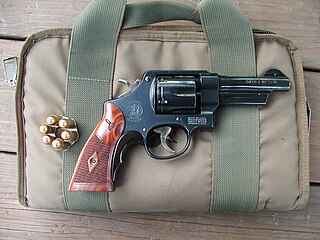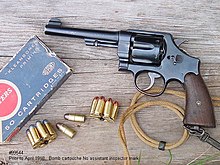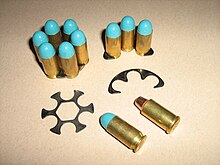
The Colt M1911 is a single-action, recoil-operated, semi-automatic pistol chambered for the .45 ACP cartridge. The pistol's formal U.S. military designation as of 1940 was Automatic Pistol, Caliber .45, M1911 for the original model adopted in March 1911, and Automatic Pistol, Caliber .45, M1911A1 for the improved M1911A1 model which entered service in 1926. The designation changed to Pistol, Caliber .45, Automatic, M1911A1 in the Vietnam War era.

The .45 ACP, also known as .45 Auto, .45 Automatic, or 11.43×23mm is a rimless straight-walled handgun cartridge designed by John Moses Browning in 1904, for use in his prototype Colt semi-automatic pistol. After successful military trials, it was adopted as the standard chambering for Colt's M1911 pistol. The round was developed due to a lack of stopping power experienced in the Moro Rebellion in places like Sulu. The issued ammunition, .38 Long Colt, had proved inadequate, motivating the search for a better cartridge. This experience and the Thompson–LaGarde Tests of 1904 led the Army and the Cavalry to decide that a minimum of .45 caliber was required in a new handgun cartridge.

The .38 Super, also known as .38 Super Auto, .38 Super Automatic, .38 Super Automatic +P , .38 Super +P , or 9×23mmSR, is a pistol cartridge that fires a 0.356-inch-diameter (9.04 mm) bullet. It was introduced in the late 1920s as a higher pressure loading of the .38 ACP, also known as .38 Auto. The older .38 ACP cartridge propels a 130-grain (8.4 g) bullet at 1,050 ft/s (320.0 m/s), whereas the .38 Super pushes the same bullet at 1,280 ft/s (390.1 m/s). The .38 Super has gained distinction as the caliber of choice for many top practical shooting competitors; it remains one of the dominant calibers in IPSC competition.

Automatic Colt Pistol (ACP) denotes various John Moses Browning cartridge designs primarily used in Colt and Fabrique Nationale de Herstal semi-automatic pistols. All of these cartridges are straight-sided and appear similar. The .32 ACP, .38 ACP, and .25 ACP are semi-rimmed and headspace on the rim, while the rimless .45 ACP and .380 ACP headspace on the mouth of the case.

The .45 Colt (11.43×33mmR), often called the .45 Long Colt, is a rimmed straight-walled handgun cartridge dating to 1872. It was originally a black-powder revolver round developed for the Colt Single Action Army revolver. This cartridge was adopted by the U.S. Army in 1873 and served as an official US military handgun cartridge for 19 years, before being replaced by the .38 Long Colt in 1892. Although there has never been a ".45 Short Colt" cartridge, the .45 Colt is frequently called the ".45 Long Colt" to better distinguish it from the shorter and less powerful .45 Schofield cartridge, which was also in use around the same time as the .45 Colt.

The .32 S&W Long / 7.65x23mmR, often called the .32 Long, is a straight-walled, centerfire, rimmed handgun cartridge, based on the earlier .32 S&W cartridge. It was introduced in 1896 for Smith & Wesson's first-model Hand Ejector revolver. Colt called it the .32 Colt New Police in revolvers it made chambered for the cartridge.

.455 Webley is a British handgun cartridge, most commonly used in the Webley top break revolvers Marks I through VI. It is also known as ".455 Eley" and ".455 Colt".
A rim is an external flange that is machined, cast, molded, stamped, or pressed around the bottom of a firearms cartridge. Thus, rimmed cartridges are sometimes called "flanged" cartridges. Almost all cartridges feature an extractor or headspacing rim, in spite of the fact that some cartridges are known as "rimless cartridges". The rim may serve a number of purposes, including providing a lip for the extractor to engage, and sometimes serving to headspace the cartridge.

A moon clip is a ring-shaped or star-shaped piece of metal designed to hold multiple cartridges together as a unit, for simultaneous insertion and extraction from a revolver cylinder. Moon clips may either hold an entire cylinder's worth of cartridges together, half a cylinder, or just two neighboring cartridges. The two-cartridge moon clips can be used for those revolvers that have an odd number of loading chambers such as five or seven and also for those revolvers that allow a shooter to mix both rimless and rimmed types of cartridges in one loading of the same cylinder.

The Smith & Wesson Model 625, is a six-round, double-action revolver chambered for the .45 ACP using moon clips. The Model 625 is an improved stainless steel version Smith & Wesson Model 22 and a direct descendant of the Smith & Wesson M1917 revolver first issued during World War I.

In American English, a pocket pistol is any small, pocket-sized semi-automatic pistol, and is suitable for concealed carry in a pocket or a similar small space.

A snubnosed revolver is a small, medium, or large frame revolver with a short barrel, generally less than 3 inches in length. Smaller such revolvers are often made with "bobbed" or "shrouded" hammers and there are also "hammerless" models ; the point is to allow the gun to be drawn with little risk of it snagging on clothing. Since the external movement of the mechanism is minimal or nil, shrouded and hammerless models may be fired from within clothing. The design of these revolvers compromises range and accuracy at a distance in favor of maneuverability and ease of carry and concealment.

The Ruger Redhawk is a DA/SA, large-frame revolver introduced in 1979 by Sturm, Ruger & Company.

S&W Centennial is a family of revolvers made by Smith & Wesson on the "J-Frame". Depending upon caliber, the cylinder holds either 5, 6, 7, or 8 cartridges. Centennials feature a fully enclosed (internal) hammer, which makes them Double Action Only (DAO) firearms. Like all other "J-frame" Smith & Wesson revolvers, they have a swing-out cylinder. Centennial models have been made in different versions like PD "Personal Defense" and LS "Lady Smith".

A handgun is a firearm designed to be usable with only one hand. It is distinguished from a long barreled gun which typically is intended to be held by both hands and braced against the shoulder. Handguns have shorter effective ranges compared to long guns, and are much harder to shoot accurately. While most early handguns are single-shot pistols, the two most common types of handguns used in modern times are revolvers and semi-automatic pistols.

In firearms, the cylinder is the cylindrical, rotating part of a revolver containing multiple chambers, each of which is capable of holding a single cartridge. The cylinder rotates (revolves) around a central axis in the revolver's action to sequentially align each individual chamber with the barrel bore for repeated firing. Each time the gun is cocked, the cylinder indexes by one chamber. Serving the same function as a rotary magazine, the cylinder stores ammunitions within the revolver and allows it to fire multiple times, before needing to be reloaded.

The .45 Auto Rim, also known as 11.5x23mmR, is a rimmed cartridge specifically designed to be fired in revolvers originally chambered for the .45 ACP cartridge.

The Smith & Wesson Model 22 is a six-shot, double-action, large frame revolver chambered in .45 ACP using moon clips. It is a refined commercial version of the M1917 revolver first issued during World War I.

The Colt New Service is a large frame, large caliber, double-action revolver made by Colt from 1898 until 1941. Made in various calibers, the .45 Colt version with a 5½" barrel, was adopted by the U.S. Armed Forces as the Model 1909.
The Smith & Wesson Model 646 is a six-shot, double-action revolver chambered for the .40 S&W pistol cartridge, manufactured in 2000 and 2003 by the United States company Smith & Wesson.























